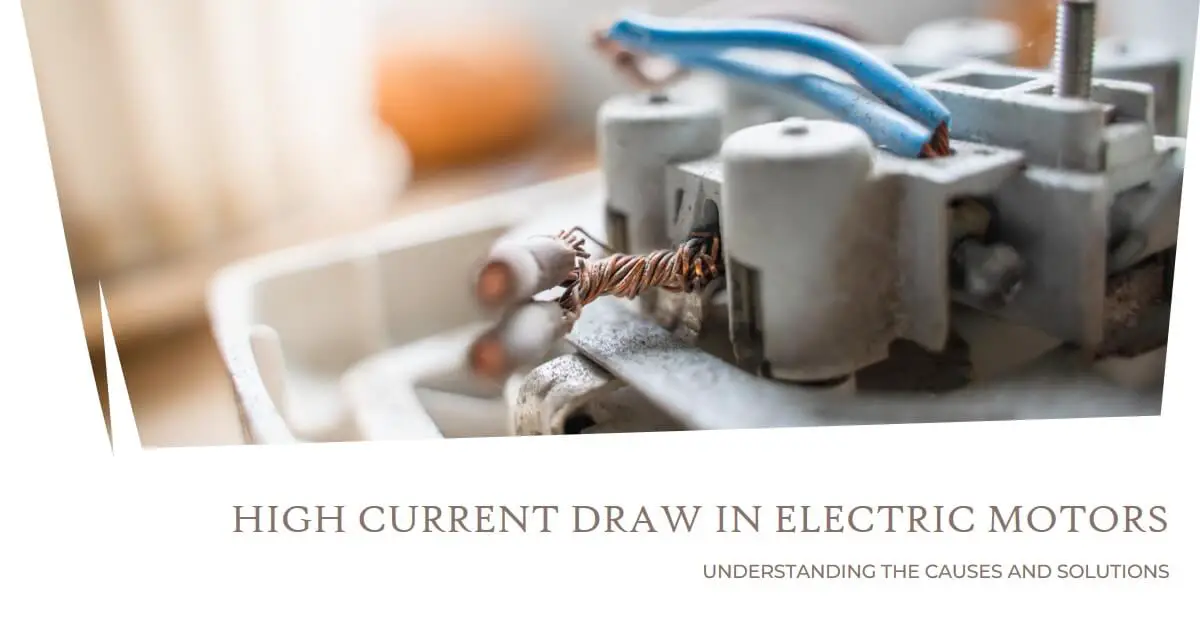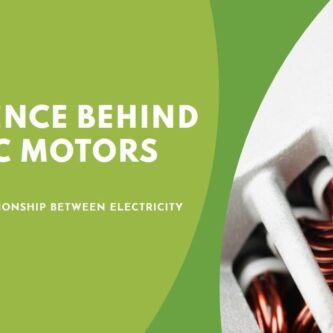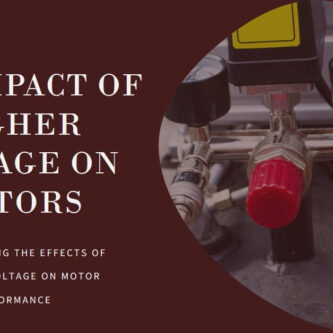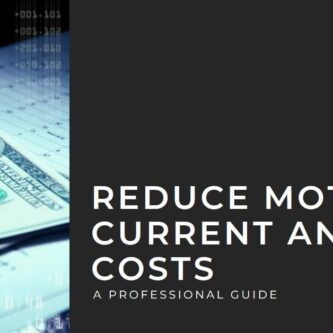Image: “Article Feature Image” by Bing is licensed under CC BY-NC-SA 4.0. Source: Bing Graphic Art. License: CC BY-NC-SA 4.0.
Electric motors play a vital role in various industries and applications, powering everything from appliances to heavy machinery.
While they are designed to operate efficiently, there are instances when an electric motor draws more current than expected.
This article aims to explore the factors that contribute to increased current draw in electric motors and the potential consequences.
Increased current draw in electric motors can be caused by several factors, including higher loads, voltage fluctuations, increased resistance, elevated temperatures, and mechanical issues such as misalignment or bearing problems.
By understanding these factors, we can take appropriate measures to prevent motor damage, optimize performance, and ensure operational safety.
Understanding Electric Motors
Electric motors are devices that convert electrical energy into mechanical energy. They work on the principle of electromagnetic induction, where a magnetic field interacts with an electric current, resulting in rotational motion.
Current is a crucial element in the functioning of electric motors, as it generates the magnetic field necessary for the motor’s operation.
Factors Affecting Current Draw in Electric Motors
Several factors can influence the current draw in electric motors, including the load, voltage, resistance, temperature, and mechanical issues.
Load
The type and magnitude of the load placed on an electric motor significantly impact its current draw.
Different loads, such as constant or variable torque, require varying amounts of current to maintain the desired speed and torque output.
For instance, a motor driving a heavy load will draw more current compared to a motor driving a lighter load.
Voltage
Voltage has a direct effect on the current draw of electric motors. A higher voltage generally leads to increased current draw, assuming the load remains constant.
Conversely, lower voltages can cause motors to draw less current. Voltage fluctuations can also affect motor performance, potentially leading to increased current draw or motor instability.
Resistance
Resistance in the motor circuit can contribute to increased current draw. Higher resistance levels result in more significant voltage drops across the circuit, which in turn require the motor to draw additional current to compensate.
Loose connections, damaged cables, or deteriorating motor windings can all contribute to increased resistance.
Temperature
Temperature plays a crucial role in the current draw of electric motors. As temperature rises, so does the resistance of the motor windings, leading to increased current draw.
Overheating can occur due to factors such as high ambient temperatures, inadequate cooling, or prolonged operation at heavy loads.
It is important to monitor and control motor temperature to prevent excessive current draw and potential motor failure.
Mechanical Issues
Various mechanical issues can cause an electric motor to draw more current than normal.
Misalignment between the motor and driven equipment can lead to increased friction and inefficiencies, resulting in higher current draw.
Similarly, bearing problems, such as insufficient lubrication or worn bearings, can cause motor inefficiency and increased current draw.
Impact of Motor Design on Current Draw
Motor design and characteristics also play a role in current draw. Factors such as motor efficiency, size, power rating, and motor type can influence the current requirements of electric motors.
Motor Efficiency
Efficiency is a crucial consideration in motor design. Motors with higher efficiency generally draw less current for a given output power.
Upgrading to more efficient motor models can reduce current draw, resulting in energy savings and improved overall performance.
Motor Size and Power Rating
The size and power rating of a motor are selected based on the intended application and load requirements.
Oversizing a motor may result in increased current draw, as the motor operates below its optimal operating range.
Conversely, undersized motors may draw more current to meet the load demands, leading to reduced motor life and potential failures.
Motor Type
Different types of electric motors, such as DC and AC motors, have unique characteristics that influence current draw.
DC motors, for example, tend to draw more current at startup due to the initial surge required to overcome inertia.
Understanding the characteristics of the motor type being used is essential in managing and predicting current draw accurately.
Read also my article: Unlocking Energy Savings: How to Reduce Motor Current and Cut Costs.
Other Factors Affecting Current Draw
Apart from the aforementioned factors, there are additional elements that can impact the current draw in electric motors.
Starting and Stopping
The process of starting and stopping an electric motor can cause temporary spikes in current draw.
During startup, the motor may experience a higher current demand to overcome inertia and initiate rotation.
Similarly, sudden stops or rapid changes in direction can result in increased current draw due to the forces involved.
Proper motor control techniques and soft-start mechanisms can help mitigate these transient current spikes.
Motor Age and Maintenance
The age and maintenance of an electric motor can influence its current draw. Over time, motors may experience wear and tear, leading to increased resistance, reduced efficiency, and subsequently, higher current draw.
Regular maintenance practices, such as lubrication, cleaning, and inspecting motor components, can help identify and rectify issues before they escalate and impact current draw.
For in-depth information read my article: The Role Of Maintenance In Workplace Safety.
Power Supply Quality
The quality and stability of the power supply can affect the current draw in electric motors. Fluctuations or disturbances in voltage, such as sags, surges, or harmonics, can result in abnormal current draw.
Utilizing appropriate voltage regulation devices, such as voltage stabilizers or surge protectors, can help maintain a stable power supply and prevent potential issues related to current draw.
Consequences of High Current Draw
High current draw in electric motors can have several adverse consequences if left unaddressed.
Overheating
Excessive current draw can lead to overheating of the motor. When the motor operates at higher current levels than intended, the increased electrical resistance generates heat.
Prolonged overheating can damage the motor’s insulation, windings, and other components, ultimately resulting in motor failure.
Read my comprehensive article: Burnout Danger: The Hidden Risks Of Motor Overheating
Motor Damage
Increased current draw can cause mechanical stress on the motor’s components, potentially leading to premature wear and damage.
Excessive current can accelerate the degradation of bearings, brushes, commutators, and other critical parts.
Regularly monitoring current draw can help identify abnormal patterns and take corrective action to prevent further damage.
Circuit Overloads
If the current draw exceeds the capacity of the electrical circuit, it can cause circuit overloads and potentially trip circuit breakers or blow fuses.
Overloaded circuits pose safety risks, as they can result in electrical fires or damage to other connected devices.
Understanding the current requirements of motors and ensuring proper circuit sizing and protection is essential to avoid such hazards.
Preventive Measures and Solutions
To mitigate increased current draw in electric motors, several preventive measures and solutions can be implemented:
Proper Motor Sizing
Selecting the appropriate motor size based on the application requirements is crucial. Oversized motors should be avoided, as they may operate inefficiently and draw unnecessary current.
Conversely, undersized motors can lead to increased current draw and reduced motor lifespan. Conducting thorough load analysis and consulting motor manufacturers’ guidelines can aid in selecting the optimal motor size.
Load Management
Efficient load management plays a significant role in controlling current draw. Distributing the load among multiple motors or employing variable frequency drives (VFDs) can optimize motor performance by matching the motor’s speed and torque to the load requirements.
By reducing unnecessary load demand, overall current draw can be minimized.
Voltage Regulation
Maintaining a stable power supply voltage is crucial to prevent current draw issues. Voltage regulation devices, such as voltage stabilizers or power conditioners, can help mitigate voltage fluctuations and ensure consistent motor performance.
These devices can stabilize the voltage within acceptable limits, reducing the risk of increased current draw.
Regular Maintenance
Implementing a proactive maintenance regime is essential to prevent increased current draw. Regularly inspecting motors, lubricating bearings, and cleaning motor components can help identify potential issues and rectify them promptly before they escalate.
Performing routine checks on electrical connections, cables, and insulation integrity can help maintain low resistance levels and prevent excessive current draw.
Additionally, monitoring motor temperature and ensuring proper cooling mechanisms are in place can prevent overheating-related current draw issues.
Conclusion
Understanding the factors that contribute to increased current draw in electric motors is crucial for optimizing motor performance, preventing motor damage, and ensuring operational safety.
Load, voltage, resistance, temperature, and mechanical issues all play significant roles in determining the current requirements of electric motors.
By carefully considering these factors and implementing appropriate preventive measures, such as proper motor sizing, load management, voltage regulation, and regular maintenance, the risk of excessive current draw can be minimized.
Ensuring a stable power supply and monitoring current draw can help identify any abnormalities and take corrective action promptly.
By maintaining optimal current draw levels, electric motors can operate efficiently, prolong their lifespan, and contribute to overall energy savings and operational reliability.
you work With Electricity! Don’t leave empty-handed!
Looking to stay ahead of the game in the world of electrical engineering? Subscribe to my YouTube channel and gain access to exclusive content you won’t find anywhere else!
The staff I recommend (Amazon Affiliate Links to products I believe are high quality):
- Economy 120 Volt/60Hz AC Power Source – Step-Down Voltage & Frequency Converters 1800W
- UNI-T Digital Multimeter Tester UT139C
- 50-Amp Extension Cord for RV “100ft”
- Voltage Stabilizer 110/220v
- Hair Dryer “best selling“
- TOSHIBA EM131A5C-BS Countertop Microwave Ovens
Disclaimer: This contains affiliate links to Amazon products. I may earn a commission for purchases made through these links.





